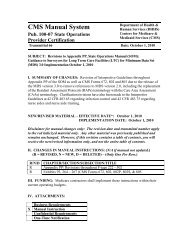2003 Louisiana Vital Statistics Report - Louisiana Department of ...
2003 Louisiana Vital Statistics Report - Louisiana Department of ...
2003 Louisiana Vital Statistics Report - Louisiana Department of ...
You also want an ePaper? Increase the reach of your titles
YUMPU automatically turns print PDFs into web optimized ePapers that Google loves.
TECHNICAL NOTES <strong>2003</strong> LOUISIANA VITAL STATISTICS REPORT<br />
DEFINITIONS<br />
The following is a glossary <strong>of</strong> technical terms used in this report:<br />
AGE-ADJUSTED DEATH RATE: a rate calculated to adjust for differences in the age structure in separate populations. The<br />
changes in the age-structure in a population can increase or decrease the likelihood <strong>of</strong> death in that population. When<br />
comparing mortality data from different populations, rates adjusted for differences in age distribution are used because age is<br />
the most significant characteristic related to disease and death. Age-adjusted death rates are artificial numbers, designed to be<br />
used only for comparisons <strong>of</strong> different populations. Unlike crude death rates, age-adjusted rates do not measure true rates <strong>of</strong><br />
death in a population. They should not be compared directly to crude death rates.<br />
AGE-SPECIFIC BIRTH RATE: a measure <strong>of</strong> the number <strong>of</strong> live births in a specific age group during a given period. Agespecific<br />
rates are calculated by dividing the number <strong>of</strong> live births occurring in a specified age group during one year by the<br />
estimated population <strong>of</strong> that age group, then multiplying the quotient by 1,000. The rate is expressed as the number <strong>of</strong> live<br />
births per 1,000 population. Age-specific rates make valid comparisons among age groups possible because age-specific rates<br />
limit their scope to narrow age ranges, thereby greatly reducing the effect that age might have on comparison <strong>of</strong> births across<br />
age groups.<br />
APGAR SCORE: a composite measure <strong>of</strong> the physical health <strong>of</strong> an infant, assessed at one and five minutes after birth, and<br />
used to predict the infant’s chances <strong>of</strong> survival. Five easily identifiable characteristics - heart rate, respiratory effort, muscle<br />
tone, reflex irritability, and color - are each assessed on a scale <strong>of</strong> zero to two, with two being optimal. The Apgar score is the<br />
sum <strong>of</strong> these scores; a score <strong>of</strong> seven or higher (to a maximum <strong>of</strong> ten) indicates that the infant is in good physical condition.<br />
BIRTH RATE (CRUDE BIRTH RATE): a measure <strong>of</strong> the number <strong>of</strong> live births in a population during a given period. Birth rates<br />
are calculated by dividing the number <strong>of</strong> live births occurring in a given population during one year by the estimated population,<br />
then multiplying the quotient by 1,000. Rates are expressed as the number <strong>of</strong> live births per 1,000 population. Birth rates are<br />
affected by the number and age distribution <strong>of</strong> women <strong>of</strong> childbearing age. Because crude birth rates relate the number <strong>of</strong> live<br />
births to the total population in an area, without regard to the age or sex distribution <strong>of</strong> the population, they are useful in<br />
projecting population changes in the area.<br />
CESAREAN SECTION: the surgical delivery <strong>of</strong> the newborn while the mother is under general anesthesia. A primary C-section<br />
refers to the first delivery by C-section. Cesarean section is usually the result <strong>of</strong> an abnormal delivery situation, once the mother<br />
has already gone into labor. The physician may choose to perform a C-section because the infant is presenting in an abnormal<br />
and potentially harmful position, as in breech birth position. Medical emergencies can also require a C-section delivery. Such<br />
emergencies include fetal distress and hemorrhaging due to ruptured placenta. A repeat C-section is a Cesarean delivery in<br />
which a woman has previously delivered by a C-section. A vaginal birth after C-section is a vaginal delivery to a woman who<br />
has previously delivered by C-section.<br />
COMPARABILITY RATIO: Measure <strong>of</strong> the degree <strong>of</strong> discontinuity between revisions <strong>of</strong> the International Classification <strong>of</strong><br />
Diseases (ICD) for a particular cause <strong>of</strong> death. Please see the Death Data section <strong>of</strong> these Technical Notes, on page 160.<br />
Page 164 <strong>Louisiana</strong> Office <strong>of</strong> Public Health, State Center for Health <strong>Statistics</strong>
















